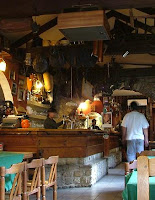About 30km north of Prague, the town of Mělník lies on a high ridge overlooking the junction of Bohemia’s two greatest rivers, the Labe and the Vltava.
The location has been inhabited since at least the 9th century, when it was a fortress of the Pšovan tribe. These river valleys from Prague to the wide bend of the Labe at Roudnice were the heartland of the earliest Czechs; the original Slavic settlers who arrived in Bohemia during the great migration of nations in the sixth and seventh centuries AD.
In the 10th Century, the Pšov fortress was replaced by an early Přemyslid castle named Mělník. Around it grew a settlement that was granted city status in the year 1274 and continued its association with the Bohemian queens when it became a queens' dowry town under the rule of Charles IV.
Originally Romanesque, the imposing church of Sts. Peter and Paul was modified over the centuries and its current appearance dates from reconstruction after a fire in 1555. The soaring clock tower can be climbed for views across Mělník’s rooftops, the vineyards stepping down to the river junction, and the forests and plains beyond.

Mělník’s main square has two straight sides and one long curved side lined with brightly painted houses of two or three floors and interrupted only by the town hall and its steeply roofed clock tower. Cars park to one side but the square is otherwise open bar a shallow fountain and a gathering of park benches and small potted trees.
Mělník lies at the centre of Bohemia’s winemaking region and any of the wine cellars scattered across the well-preserved historic centre of town or even the chateau itself are good places to sample the local drop. There is also excellent traditional food available at restaurants like U Benišků and a nifty little teahouse café spread across the four floors of the old gothic Prague gate tower.
Expect to pay 75-100Kč for a meaty meal at U Benišků and about 40Kč for a glass of wine at any of the local bars. If you’d prefer something for home the chateau cellars have the local Ludmila reds and whites in attractive bottles for 110-140Kč.
Tuesday, 24 February 2009
Mělník
Subscribe to:
Post Comments (Atom)







8 comments:
One of my fave Czech towns.
You've done it proud.
Cheers Michael! That gives me a little confidence boost for the place I want to write about next, which I suspect is your absolute favourite Czech city...
Would that be my favourite Czech city whose branch of Husa has just put the price of a ten degree beer up to fifty crowns in order to rip off (non-existant) visitors to an international skiing event?
The same Czech city's top police officer has just been arrested on bribery charges too.
Makes me feel better about living in Latvia ;)
I hadn't heard about the 50Kč beers, but yep, that's the one...
No-one should really being drinking at any Husa anywhere in the land anyway...
Hehe! My feelings exactly.
great blog Captain
Thanks Daniel!
Post a Comment